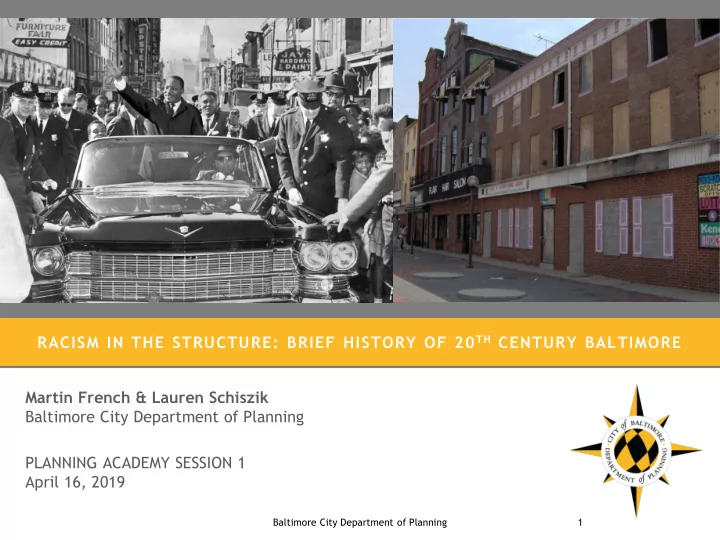

RACISM IN THE STRUCTURE: BRIEF HISTORY OF 20 TH CENTURY BALTIMORE Martin French & Lauren Schiszik Baltimore City Department of Planning PLANNING ACADEMY SESSION 1 April 16, 2019 Baltimore City Department of Planning 1
R ACISM IN THE S TRUCTURE Which Structure? Built Environment Legal Structure Regulatory Structure • How were these structures created and upheld over time? • How have they impacted generations of citizens? • How can we ensure that planning is inclusive and equitable today? Baltimore City Department of Planning 2
D EVELOPMENT H ISTORY Which Structure? Baltimore originally was 3 separate towns in Baltimore County: Baltimore Town, Jonestown, Fell’s Point In 1851, Baltimore City became its own jurisdiction, separate from the surrounding County Source: “Inventory of Residential Blight: Findings. Baltimore, Maryland.” Baltimore Urban Renewal And Housing Agency, October 1964. Used with permission of the University of Baltimore. 3
D EVELOPMENT H ISTORY 1867 Map of Baltimore Source: “Map of Baltimore, 1867” by Samuel Augustus Mitchell. Wikimedia Commons Baltimore City Department of Planning 4
B UILT E NVIRONMENT Circa 1860 Plat Map Aerial view of same block today Baltimore City Department of Planning 5
B UILT E NVIRONMENT 1893 “Slum” Criteria Considerations: Baltimore City Department of Planning 6
“We did not move up there L EGAL S TRUCTURE - L OCAL because we wished to force 1910 Segregation Housing Ordinance our way among the whites; association with them in a social way would be just as distasteful to us as it would be to them. We merely desired to live in more commodious and comfortable quarters… As for property deteriorating on account of our advent into that neighborhood, I know it cannot be so, because all of us are paying higher rentals than the white occupants who immediately preceded us, and there is no better criterion of value than the rent a property brings.” - George W. McMechen, quoted in NY Times, December 25, 1910 Baltimore City Department of Planning 7
1937 FHA Residential Security Map R EGULATORY S TRUCTURE - F EDERAL KEY First Grade Second Grade Third Grade Fourth Grade Baltimore City Department of Planning 8
P RIVATE D ISCRIMINATORY A CTIONS Restrictive Housing Covenants Illustration from Gardens, Houses and People, Vol. XII, No. 4, April 1937, published by The Roland Park Company. Baltimore City Department of Planning 9
F IGHTING P RIVATE D ISCRIMINATORY A CTIONS Fighting Restrictive Housing Covenants 1917 Ad in the Afro-American for Wilson Park. Baltimore City Department of Planning 10
P RIVATE D ISCRIMINATORY A CTIONS Blockbusting “Would you panic if a Negro moved next door?,” Newberry Digital Exhibitions , accessed April 11, 2019, http://publications.newberry.org/digital_exhibitions/items/show/96. Baltimore City Department of Planning 11
F IGHTING P RIVATE D ISCRIMINATORY A CTIONS Fighting Blockbusting Baltimore City Department of Planning 12
R EGULATORY S TRUCTURE - L OCAL 1949 Zoning Map KEY First Commercial Second Commercial Industrial Baltimore City Department of Planning 13
R EGULATORY S TRUCTURE - F EDERAL 1940s Slum Clearance Baltimore City Department of Planning 14
B UILT E NVIRONMENT Slum Clearance for Public Housing Perkins Homes. Source: Mark Steiner Show. Baltimore City Department of Planning 15
R EGULATORY S TRUCTURE – F EDERAL AND L OCAL Slum Clearance as Urban Renewal Baltimore City Department of Planning 16
R EGULATORY S TRUCTURE – F EDERAL , S TATE , L OCAL Highways as Slum Clearance Citizens in South Baltimore stopped a highway through downtown and the waterfront... Source: Baltimore City Department of Planning 17
R EGULATORY S TRUCTURE – F EDERAL , S TATE , L OCAL But the “Highway To Nowhere” went through the heart of West Baltimore Construction of I-170 destroyed 970 homes Baltimore City Department of Planning 18
R EGULATORY S TRUCTURE Urban Renewal, Human Renewal “The final stage [of urban blight] … is equivalent to the death of part of the city’s tissue. Human existence and economic activity in such areas become moribund. Subsequently, the affected locales become breeding places for crime, disease, pestilence, poverty and human despair. Transference of these ill-effects to other parts of the city is swift and deadly. “When this stage of physical degradation is reached, surgery or removal of slums constitutes only part of the cure for urban decay. Substandard social and economic circumstances of the people who live in such slums do not disappear when decayed slum structures are removed. Unless “human renewal” – improvement of the social and economic conditions of people – is achieved, the conditioning factors…are merely shifted to other areas…” - Baltimore Urban Renewal and Housing Agency (BURHA) Community Renewal Program report, 1964 Baltimore City Department of Planning 19
A DDRESSING THE L EGACY OF D ISCRIMINATORY T OOLS Community-led Revitalization Baltimore City Department of Planning 20
Planning Academy 2019 Discussion Baltimore City Department of Planning 21
Recommend
More recommend